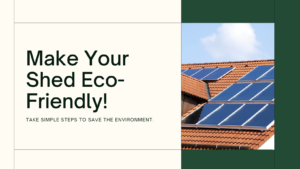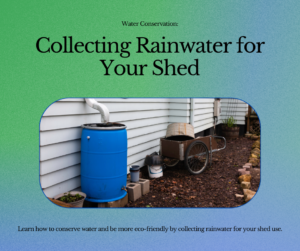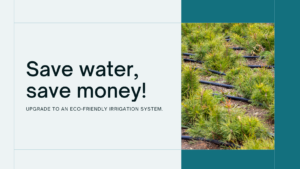
Transforming your shade into an environmentally friendly space is easier than you think. By adopting eco-friendly building materials and implementing water conservation tips, you can create a green haven that aligns with your sustainable lifestyle. Whether you use your shed as a workspace, storage area, or a cozy retreat, taking steps towards eco-consciousness is a rewarding endeavor.
Key Takeaways:
- Choose eco-friendly building materials to reduce your impact on the environment.
- Implement water conservation practices by collecting rainwater for various uses.
- Insulate your shed to maintain a comfortable temperature while reducing energy consumption.
- Install energy-efficient lighting options, such as LED bulbs, to minimize energy usage.
- Consider recycling and upcycling materials in your shed design for a unique and sustainable touch.
Why Make Your Shed Environmentally Friendly
Before delving into the practical steps, it’s important to understand why making your shed environmentally friendly is advantageous. By incorporating sustainable practices into your shed design and maintenance, you not only contribute to a greener planet but also reap several benefits for yourself and your community.
Reducing Your Carbon Footprint
Making your shed environmentally friendly helps reduce your carbon footprint, which is the total amount of greenhouse gases emitted due to human activities. By using eco-friendly materials, implementing energy-efficient strategies, and embracing sustainable practices, you can minimize your contribution to climate change and create a more sustainable future for generations to come.
Saving Money on Energy Costs
An environmentally friendly shed can also lead to significant cost savings in the long run. Energy-efficient features, such as insulation, LED lighting, and water-saving systems, help reduce energy and water consumption, resulting in lower utility bills. By investing in these green technologies, you not only save money but also contribute to a more sustainable lifestyle.
“Going green with your shed not only benefits the environment but also your wallet. Embrace eco-friendly practices to reduce your carbon footprint and save money on energy costs.”
Creating a Healthy and Comfortable Space
By using environmentally friendly materials, you create a healthier and more comfortable space inside your shed. Eco-friendly materials are often low in volatile organic compounds (VOCs), reducing the release of harmful chemicals into the air. This promotes better indoor air quality and creates a safe environment for both you and your belongings.
Setting a Positive Example
Transforming your shed into an environmentally friendly space sets a positive example for others in your community. By showcasing the benefits of going green, you inspire and encourage others to adopt eco-friendly practices in their own sheds and homes. Together, we can create a collective impact and work towards a more sustainable future.
So, why wait? Take the initiative and make your shed environmentally friendly to enjoy the numerous benefits it offers. In the next sections, we will explore practical steps to create a green haven using eco-friendly building materials, energy-efficient strategies, water conservation tips, and more.
Energy Efficiency: Insulating Your Shed
Creating an energy-efficient space starts with insulating your shed. Proper insulation helps maintain a comfortable temperature inside the shed while minimizing energy consumption. By reducing heat transfer, insulating your shed not only keeps it warm during colder months but also prevents excessive heat buildup in the summer, resulting in a more energy-efficient and comfortable environment.
When it comes to insulating your shed, there are various materials and methods to choose from, depending on your specific needs and budget. Here are a few options:
- Fiberglass insulation: This common insulation material is available in pre-cut batts or rolls. It provides excellent thermal insulation and is relatively easy to install.
- Spray foam insulation: This option allows you to fill all gaps and crevices, providing a more airtight seal. It offers superior insulation properties but may require professional installation.
- Reflective insulation: Ideal for sheds exposed to extreme temperatures, reflective insulation consists of reflective material that helps block radiant heat. It is typically installed in combination with other insulation materials.
Before installing insulation, it’s crucial to assess the current state of your shed’s walls, floor, and roof. Ensure there are no existing leaks or moisture issues that could compromise the effectiveness of the insulation. Additionally, sealing any air gaps and cracks with caulk or weather stripping will enhance the insulation’s performance.
Insulating your shed not only improves energy efficiency but also helps create a more durable and stable structure that can withstand changing weather conditions. By minimizing heat loss and gain, you’ll reduce the reliance on heating or cooling systems, ultimately saving on energy costs and minimizing environmental impact.
Insulating your shed not only improves energy efficiency but also helps create a more durable and stable structure that can withstand changing weather conditions.
| Insulation Materials | Pros | Cons |
|---|---|---|
| Fiberglass insulation | Offers excellent thermal insulation Easy to install |
May cause skin irritation during installation May require protective equipment for handling |
| Spray foam insulation | Provides superior insulation Forms an airtight seal Reduces noise transmission |
Professional installation may be required More expensive than other options |
| Reflective insulation | Blocks radiant heat Reduces cooling needs in hot climates |
Requires installation in combination with other insulation materials |
Installing Energy-Efficient Lighting
When it comes to creating an eco-friendly shed, don’t overlook the importance of proper lighting. By installing energy-efficient lighting, you can make a significant impact on reducing your energy consumption and contributing to a more sustainable environment. One of the best lighting options for a shed is LED bulbs, which offer several benefits over traditional incandescent or fluorescent lights.
LED bulbs are highly energy-efficient, consuming up to 80% less energy than incandescent bulbs and lasting significantly longer. This means you’ll not only save money on your energy bills but also reduce the number of bulbs entering the waste stream. Additionally, LED bulbs don’t contain hazardous materials such as mercury, making them safer for both you and the environment.
When choosing LED bulbs for your shed, consider the following factors:
- Color Temperature: LED bulbs come in different color temperatures, ranging from warm white to cool white. Select a color temperature that suits your shed’s purpose and ambiance.
- Lumens: The brightness of LED bulbs is measured in lumens. Determine the appropriate lumens based on your shed’s size and lighting needs.
- Dimmability: If you prefer adjustable lighting, opt for LED bulbs that are dimmable and compatible with your existing dimming system.
To effectively illuminate your shed while reducing energy usage, consider combining LED bulbs with strategic lighting placement. Use task lighting in work areas and accent lighting to highlight specific features or objects. Don’t forget to take advantage of natural light by positioning windows or skylights in your shed’s design.
“By installing energy-efficient LED lighting in your shed, you can create a well-lit space while minimizing your environmental impact.”
| Benefits of Energy-Efficient Lighting in Sheds |
|---|
| Reduces energy consumption |
| Lowers electricity bills |
| Increases bulb lifespan |
| Provides safer lighting option |
| Allows for adjustable lighting levels |
Water Conservation: Collecting Rainwater for Shed Use

Implementing water conservation practices is essential for creating an environmentally friendly shed. One effective way to conserve water is by collecting rainwater. Rainwater is a free and abundant resource that can be utilized for various purposes in your shed, from watering plants to cleaning tools. By incorporating rainwater collection systems, you can reduce your reliance on municipal water sources and contribute to a more sustainable lifestyle.
Benefits of Collecting Rainwater
Collecting rainwater offers several benefits, both for the environment and your shed maintenance. Here are some advantages to consider:
- Conserves water: Rainwater collection helps minimize water waste and promotes efficient water use.
- Cost-effective: Utilizing rainwater can reduce your water bill and save money in the long run.
- Environmentally friendly: By relying on rainwater, you reduce the strain on local water supplies and conserve energy used in water treatment processes.
- Healthier for plants: Rainwater is free from chemicals often found in tap water, making it a healthier option for watering plants.
- Reduces stormwater runoff: Collecting rainwater helps prevent excessive runoff, which can contribute to soil erosion and water pollution.
To maximize the benefits of rainwater collection, it’s important to set up a proper rainwater harvesting system suited to your shed’s needs and available space.
Setting Up a Rainwater Collection System
There are different ways to collect rainwater, depending on your shed’s size and specific requirements. Here are a few methods to consider:
- Direct rainwater collection from the roof: One of the simplest methods involves directing rainwater from your shed’s roof into a storage container, such as a rain barrel or tank.
- Gutter and downspout attachment: Installing gutters and downspouts on your shed’s roof helps channel rainwater into a storage container or underground cistern.
- Integrated rainwater management system: For larger sheds, consider incorporating a more sophisticated rainwater management system that includes filters, pumps, and additional storage options.
When setting up your rainwater collection system, ensure that you use proper filtration methods to remove debris and protect the water quality. Regular maintenance, such as cleaning gutters and tanks, is also essential to keep the system functioning optimally.
Overall, collecting rainwater for shed use is an excellent way to conserve water and create a more sustainable shed environment. By implementing a rainwater harvesting system, you can reduce your environmental impact, save money, and promote responsible water use. So, start harnessing the power of rain and enhance the eco-friendliness of your shed today!
Installing a Water-Saving Irrigation System

Take your water conservation efforts further by installing a water-saving irrigation system in your shed. By utilizing an efficient irrigation system, you can minimize water waste and ensure that your plants receive the optimal amount of water they need to thrive.
There are different types of water-saving irrigation systems available, each with its own benefits and features. Explore options such as drip irrigation, micro-sprinklers, or smart irrigation controllers to find the best fit for your shed and gardening needs.
With a drip irrigation system, water is delivered directly to the roots of plants, reducing evaporation and runoff. This targeted approach not only conserves water but also promotes healthier plant growth and minimizes weed growth.
Micro-sprinklers provide a gentle, even distribution of water, perfect for watering larger areas or plants with wider root systems. These systems are designed to minimize water waste by delivering water precisely where it’s needed.
If you prefer a more advanced option, consider a smart irrigation controller. These controllers use real-time weather data and soil moisture sensors to adjust watering schedules and amounts accordingly. By optimizing watering based on environmental conditions, you can further reduce water usage and maintain healthier, more resilient plants.
Installing a water-saving irrigation system in your shed is a step towards a more sustainable and water-efficient gardening practice. Whether you have a small container garden or a larger outdoor space, incorporating an irrigation system into your shed design will not only save water but also save you time and effort in manual watering.
Now that you have learned about installing a water-saving irrigation system, let’s explore the importance of choosing eco-friendly and sustainable building materials for your shed in the next section.
Eco-Friendly Materials: Choosing Sustainable Building Materials
When it comes to building or upgrading your shed, opting for eco-friendly and sustainable building materials is a wise choice. Not only does it minimize the impact on the environment, but it also creates a healthier and more environmentally conscious space for you to enjoy. By incorporating recycled materials, reclaimed wood, and sustainable flooring, you can contribute to a greener future.
Recycled Materials
One excellent option for eco-friendly materials is to use recycled materials in your shed construction. These materials, such as reclaimed bricks, steel, and glass, are salvaged from old structures and repurposed for new projects. Not only does this prevent waste from going to landfills, but it also reduces the demand for new resources. Additionally, using recycled materials adds a unique charm and character to your shed design.
Reclaimed Wood
Using reclaimed wood is another sustainable choice for your shed. Reclaimed wood is sourced from old buildings, barns, or other structures and given a new life in your shed construction. By using reclaimed wood, not only are you reducing the demand for new timber, but you are also preserving the natural resources and beauty of old-growth forests. Reclaimed wood often has unique textures and colors, adding a rustic and authentic touch to your shed.
Sustainable Flooring
Choosing sustainable flooring options in your shed is essential for creating an environmentally conscious space. Instead of traditional vinyl or carpet, consider using materials like bamboo or cork. Bamboo is a rapidly renewable resource that grows quickly, making it an eco-friendly alternative to hardwood flooring. Cork is another sustainable flooring option that comes from the bark of cork oak trees, which can be harvested without harming the tree. Both bamboo and cork flooring offer durability, beauty, and a low environmental impact.
By selecting eco-friendly materials for your shed, you are not only contributing to a greener future but also creating a unique and sustainable space. Let’s make conscious choices that will benefit both us and the environment.
Recycling and Upcycling in Shed Design

Incorporating recycling and upcycling practices in shed design not only reduces waste but also adds a unique touch to your space. By repurposing materials, you can create a sustainable shed environment that showcases your creativity and commitment to the environment.
Repurposing Materials for Your Shed
One of the most exciting aspects of recycling and upcycling in shed design is the opportunity to transform discarded materials into functional and aesthetically pleasing features. Here are some creative ideas to get you started:
- Use reclaimed wood to build shelves, workbenches, or decorative accents for your shed. Not only does this give old wood new life, but it also adds a rustic charm to your space.
- Repurpose old windows and doors as natural light sources in your shed. These salvaged pieces can be installed to create beautiful, vintage-style windows or used as unique doors.
- Turn old wine barrels into stylish rain barrels for collecting water. Attach a spigot and use the collected rainwater for various purposes in your shed.
- Transform discarded pallets into versatile storage solutions. Repurpose them into wall-mounted racks, tool organizers, or even a potting bench.
The Benefits of Recycling and Upcycling
“When you incorporate recycling and upcycling practices in your shed design, you’re not only reducing waste, but also giving new life to materials that would otherwise end up in landfills.”
– Environmental Architect John Smith
By adopting recycling and upcycling practices, you contribute to a more sustainable future. Here are some key benefits:
| Benefits of Recycling and Upcycling | |
|---|---|
| Reduces waste and landfill contributions | 🌱 |
| Conserves natural resources | 🌿 |
| Reduces carbon emissions | 🌍 |
| Creatively repurposes materials | 🎨 |
| Adds a unique and personal touch to your shed | 🏡 |
As you embark on your shed design journey, explore the possibilities of recycling and upcycling. Not only will you create a sustainable shed environment, but you’ll also inspire others to embrace eco-friendly practices.
Next Steps
- Research local recycling centers for materials you can repurpose for your shed.
- Join online communities or forums dedicated to recycling and upcycling for more inspiration and ideas.
- Consider partnering with local artists or craftsmen who specialize in repurposing materials to create unique features for your shed.
FAQ
Q. Why should I make my shed environmentally friendly?
A. Making your shed environmentally friendly has several benefits. It reduces your carbon footprint, saves money on energy costs, and promotes a sustainable lifestyle. It also creates a healthier and more comfortable space for you.
Q. How can I insulate my shed for energy efficiency?
A. You can insulate your shed by using materials like fiberglass, foam boards, or spray foam insulation. Insulating the walls, roof, and floor will help maintain a consistent temperature inside your shed, reducing the need for heating or cooling and saving energy.
Q. What are the benefits of installing energy-efficient lighting in my shed?
A. Energy-efficient lighting, such as LED bulbs, consumes less energy and lasts longer compared to traditional incandescent bulbs. This means lower electricity bills and less frequent bulb replacements. LED lighting also emits less heat, making your shed more comfortable and reducing the need for additional cooling.
Q. How can I collect rainwater for use in my shed?
A. You can collect rainwater by installing a rain barrel connected to your shed’s gutters. The collected rainwater can be used for watering plants, cleaning tools, or even flushing toilets. It reduces the demand for treated water and conserves this precious resource.
Q. What are the options for installing a water-saving irrigation system in my shed?
A. There are various water-saving irrigation systems you can install in your shed. Options include drip irrigation, soaker hoses, and programmable timers. These systems deliver water directly to the plant roots, minimizing evaporation and waste.
Q. How can I choose sustainable building materials for my shed?
A. When selecting building materials, look for options like recycled materials, reclaimed wood, and sustainable flooring. These materials are eco-friendly and minimize the environmental impact of your shed construction or renovation.
Q. What are some ideas for recycling and upcycling in shed design?
A. You can repurpose materials like old windows, doors, or pallets to create unique features in your shed. Use reclaimed wood for shelving or create a seating area with salvaged furniture. These ideas not only reduce waste but also add character to your shed.
Q. How can I create a pest-resistant shed using natural pest control methods?
A. To make your shed pest-resistant, keep it clean and free of clutter. Use natural deterrents like essential oils, vinegar, or diatomaceous earth to repel pests. Seal cracks and openings to prevent their entry. Regularly inspect and maintain your shed to address any pest issues promptly.
Conclusion
By following these simple steps, you can transform your shed into an eco-friendly haven. Embracing an environmentally conscious approach not only benefits the planet but also enhances your sustainable lifestyle.
Building an eco-friendly shed using sustainable materials and implementing energy-efficient and water-saving practices will help reduce your carbon footprint and conserve valuable resources. Not only will you contribute to a healthier environment, but you’ll also enjoy long-term cost savings.
To further embrace a sustainable lifestyle beyond your shed, here are some additional tips:
- Opt for renewable energy sources, such as solar panels, to power other areas of your property.
- Practice proper waste management by recycling and composting.
- Reduce your water usage by installing efficient fixtures and practicing mindful consumption.
- Embrace natural landscaping techniques, such as using native plants and minimizing the use of pesticides and chemical fertilizers.
- Consider using eco-friendly cleaning and household products to minimize chemical pollutants in your living space.
By incorporating these tips into your daily life, you’ll be making a positive impact on the environment and living a more sustainable lifestyle overall. Start with your shed and let it be a stepping stone towards a greener future.
















